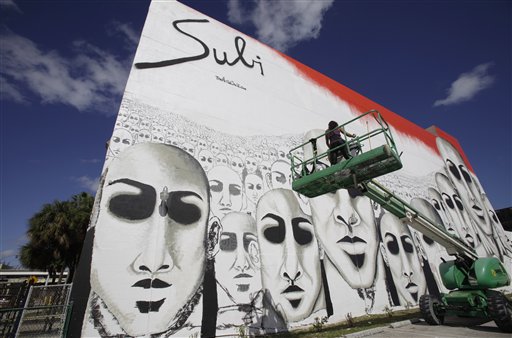
Like most art galleries in Chelsea, Mallick Williams & Co. is usually open from 10 a.m. to 6 p.m., Tuesday to Friday, with more limited hours on Saturday.
But last week, the small gallery at 11th Avenue and West 22nd Street failed to open at all. Instead, Mallick Williams, like many Chelsea galleries, was participating in Art Basel Miami Beach, an annual event widely considered the most important art fair in North America.
Art Basel Miami Beach, which celebrated its 10th anniversary this year, draws art galleries from all over the world — including 80 based in New York. They come to meet new customers and move artwork at the fair, which is modeled on the original Art Basel, started in Basel, Switzerland, in 1970. The Miami event also includes a number of smaller shows, such as the SCOPE Art Show, in which Mallick Williams & Co. participated.
Galleries must apply to participate in Art Basel Miami Beach, and going can be a point of pride. Ameringer McEnery Yohe, a gallery on West 22nd Street, boasts on its website that it has been “selected for inclusion” at Art Basel Miami Beach every year since the fair began in 2002.
Many of the New York galleries represented are larger ones, like The Pace Gallery and Matthew Marks Gallery, both of which have multiple Manhattan locations. Matthew Marks sent at least five people this year with a variety of artwork, said Reed Handley, who works at the gallery’s West 24th Street location. “It’s a big deal in the industry,” she said. “A lot of people go.”
According to an assistant at one Chelsea gallery that participated this year, who requested anonymity to discuss specific figures, her gallery brought about 80 works to Miami this year: 60 or so by living artists and 20 by deceased ones. This year, her gallery tried to move lower-priced priced pieces at higher volumes. “That’s been a trend since 2009,” she said, when the recession hit art buyers’ wallets. “Prior to that it was the opposite.”
But business, the assistant said, was surprisingly good this year; her gallery sold about half the works it brought down.
Larger galleries don’t typically shutter for a week like Mallick Williams did, but they may sell less art and operate with smaller staffs. Asked about Art Basel Miami Beach last week, an assistant at Sikkema Jenkins & Co. said that everyone at the gallery who typically fielded questions was in Miami.
But many smaller Chelsea galleries choose to skip Miami entirely, both the main fair and smaller shows like SCOPE. Art Basel Miami Beach has something of a party reputation, which Adam Lindemann mocked in a talked-about piece in The New York Observer last week. Why, he asked, “should I be seen rubbing elbows with all those phonies and scenesters, people who don’t even pretend they are remotely interested in art?”
One Chelsea gallery director, who requested anonymity to discuss Art Basel without alienating fellow gallery owners, said her gallery had participated in Art Basel Miami Beach in 2010 but had chosen not to go this year. “We feel that Miami is less important than it used to be,” she said, adding that the slower economy meant art fairs in general were less profitable.
Instead, the director spent her gallery’s art fair budget participating in Art Hong Kong in May, which she said attracted a different clientele; in Miami, many of the buyers are Americans who might buy her art, anyway. Still, she said, “that doesn’t mean we won’t return in the future.”